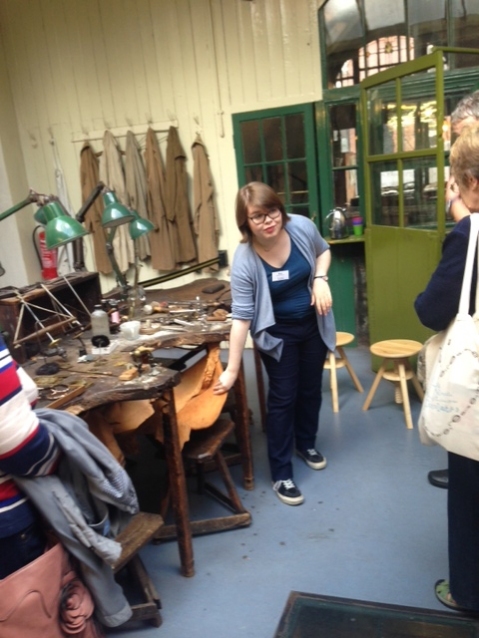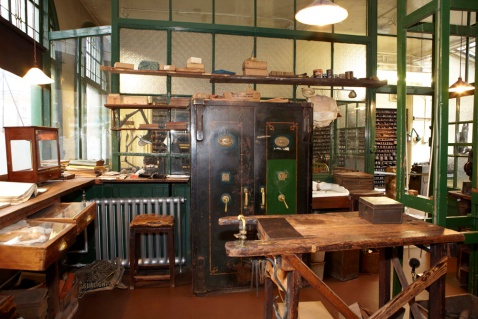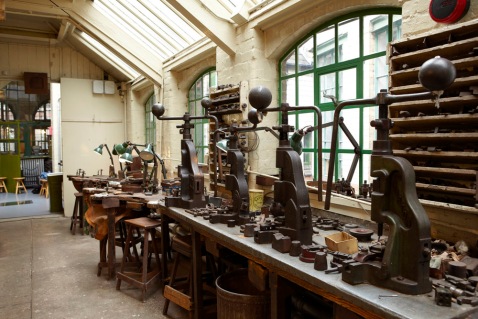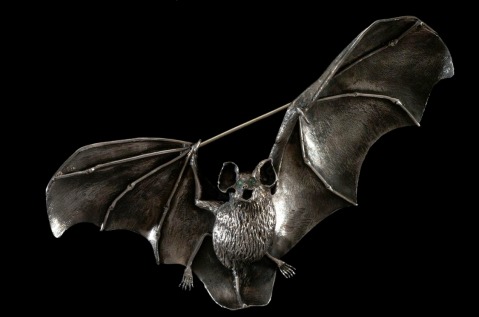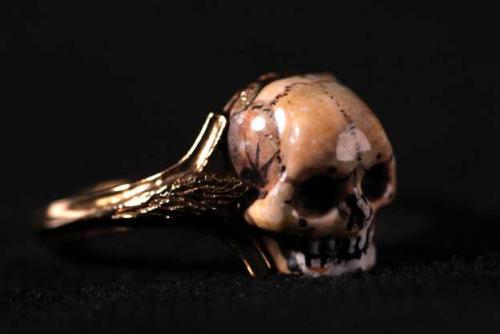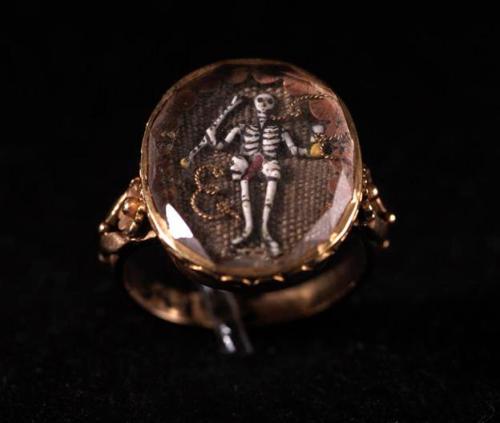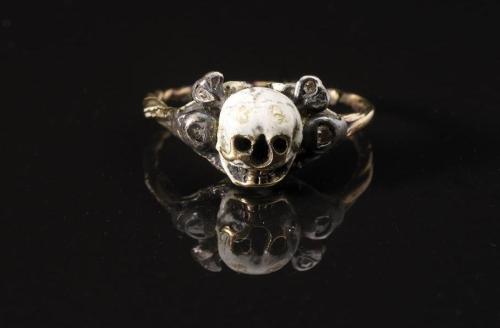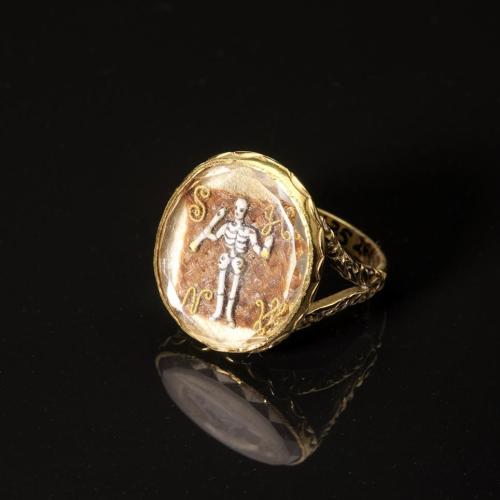Volunteering at the Museum of the Jewellery Quarter
Fly press, drop stamp, jeweller’s wig, Archimedes drill, draw bench; a few months ago these terms would have been completely alien to me but that was until I started volunteering at the Museum of the Jewellery Quarter (MJQ). My name is Beth, I have a degree in medieval history, and every Tuesday can be found at MJQ being a volunteer guide.
As a recent history graduate I knew that if I was to entertain any hope of forging a career in Museums and Heritage I had to be willing to volunteer. With this in mind I began scanning the local Heritage sites and Museums for opportunities. There’s no lack of them I can tell you but I quickly stumbled upon an intriguing advert on the Birmingham Museums and art Gallery website (http://www.bmag.org.uk/support-us/volunteer). The advert was asking for guides to help out at the Museum of the Jewellery Quarter. I must confess before seeing this advert I’d never heard of the Museum of the Jewellery Quarter but having volunteered and worked in a range of places from being a medieval wench at Warwick castle to a custodian at the Great Hall in Winchester whilst I was studying for my degree I knew the importance of leaping at an opportunity when it presents itself (one such leap has also seen me gallivanting around as an authentically dressed Elizabeth I). What I can say is I’m glad I took that leap and I will tell you for why…
Right from my first visit to MJQ I was impressed, partly because it involved the most enjoyable interview I’ve ever had (that’s right, an enjoyable interview! Who knew?). By my second trip I was determined to be impressed and that’s before I’d even set foot in the museum. When I did get my much anticipated tour I was not disappointed.
For those of you reading this who’ve never visited the Museum of the Jewellery Quarter I feel that to call it a museum is a bit of a misnomer, its more like a giant time capsule taking you back to the golden age of jewellery manufacturing in Birmingham. My role as a volunteer is to take our guests around the abandoned works of a former jewellery firm, Smith and Pepper, including demonstrating some of the machines and techniques that would have been used when it was a business. After trading for 82 years they abandoned their premises in 1981, locking the doors and allowing all the old equipment and records to gather dust for the next 9 years at which point it was turned into the museum. The former owners even kindly left behind a jar of marmite just in anyone gets peckish during the tour. Of course I could go on in great detail, but if you want to hear the rest of Smith and Pepper’s intriguing past you’ll have to come and visit us in person for the full tour (for details on how to find MJQ click on the link: http://www.bmag.org.uk/museum-of-the-jewellery-quarter).
I can’t deny that preparing to do my first museum tour was quite a nerve wracking experience. Most people would find memorizing 45 minutes to an hour’s worth of material and regurgitating this on demand a daunting experience and I was no different, although it helped knowing that no one was going to rush me into doing a tour before I was ready. As it happens I was pretty confident by my second week thanks to the constant prompts around the museum that help me to memorize all the stories of the people who used to work in this busy manufacturing business. I was a little more anxious when it came to working with the machinery in the factory but under the careful eye of the museum staff I’m getting there.
One of the joys of working at MJQ is how much I’ve learnt even in relatively short time I’ve been there. I now know a fly press can be used to cut out shapes in metal, for example those cute little charms you might find on a charm bracelet, if you want to impress a pattern into metal you’ll need a drop stamp and for those fine, fiddly holes to thread things through you’ll want an Archimedes drill (no electric drill here, thank you!). But is not just the information for the tours, but also from the many guests to the museum who share memories of working in similar factories or trades when they were younger.
For those reading this and wondering whether volunteering is your kind of thing, my advice to you is give it a go, you never know what exciting things you might find out.
Beth Williams,
Volunteer Tour Guide at MJQ
If you’re interested in volunteering for Birmingham Museums Trust, then find out more at: http://www.bmag.org.uk/support-us/volunteer
On the Quest for Jewelled Creatures
As half term approaches I was reminded of a game I used to play with my daughter when she was young enough to be distracted by such things. “You’re making an imaginary farm can you find enough animals here to go in it?” It might seem an odd thing to say in a museum devoted to history and art and without displays of stuffed animals but BMAG is stacked full of creatures. You just need to know where to look.
I’ve begun my search in the Jewellery Gallery. Tucked away at the top of the stairs in the Industrial Gallery it is a space which often gets overlooked. It is arranged along two corridors: one with displays of jewellery from around the world and the other containing British and European jewellery collected and donated to the Museum by Mrs Hull-Grundy.
It doesn’t take long to spot my first animal: a dazzling golden peacock with a fringe of red paste rubies and emerald coloured tail feathers. He’s sitting on top of a French nineteenth century frontlet. Frontlets are elaborate bands fixed to the large combs needed to keep the equally large late Victorian ladies’ hair-dos in place. You could keep the comb and change the frontlet to suit the occasion. Many of them are made from imitation materials. This one uses pinchbeck to simulate gold and paste to suggest gemstones. But across a candlelit table the deception could go unnoticed.
Although peacocks do eat small snakes I think this one would prefer not to attract the attention of the earrings in the adjoining case – a pair of golden cobras from the Nilgiri Hills in southern India – which look like they are just about to pounce on unsuspecting prey.
If I was looking for something a bit more suitable to feed my peacock I might be tempted by the large blue enamelled butterfly from the London firm of Child and Child or even the waist-clasp made in the shape of a monster beetle in gilt copper, glass and paste.
I realise as I continue that it would be a hard task to stock a traditional farm from the jewellery here. Apart from a delicate gold stick pin decorated with a running boar attributed to the French maker Paul Robin in the 1870s and a Swiss ivory horse head brooch and earring set I would do better setting my sights on a wildlife reserve.
There are plenty of contenders here but there is one in particular which caught my attention: a French brooch in the shape of a flying bat made c. 1900.
I’m undecided as whether this bat is intended to be hungry or intimidating with his open mouth and bright, staring eyes. He would have been an attention grabber perched on a lady’s’ coat but I don’t think I would have chosen to wear him.
If you prefer dogs then you might like the enamelled sad-eyed pug on a brooch by the London firm of William Bishop Ford in 1875. Jewellery featuring animals was popular in the Victorian period and makers were often commissioned to produce brooches to commemorate a favourite pet.
He wears a red enamelled collar to symbolise his loyalty and obedience.
There are many other animals hidden away on pieces of jewellery in the gallery and of course if you want to take it further just about every gallery in the Museum will turn up animals both real and fantastic.
You might need to plan an extension to that farm.
Sylvia Crawley,
Curator (Applied Art)
Memento Mori Rings – Skulls and Skeletons!
It is Halloween Night at the Museum Collections Centre tonight and so with Halloween in mind I thought I’d share a few of these marvellous memento mori rings. They were often bequeathed in wills to close friends and family to be worn as a reminder to the wearer of the departed!
M547.261

